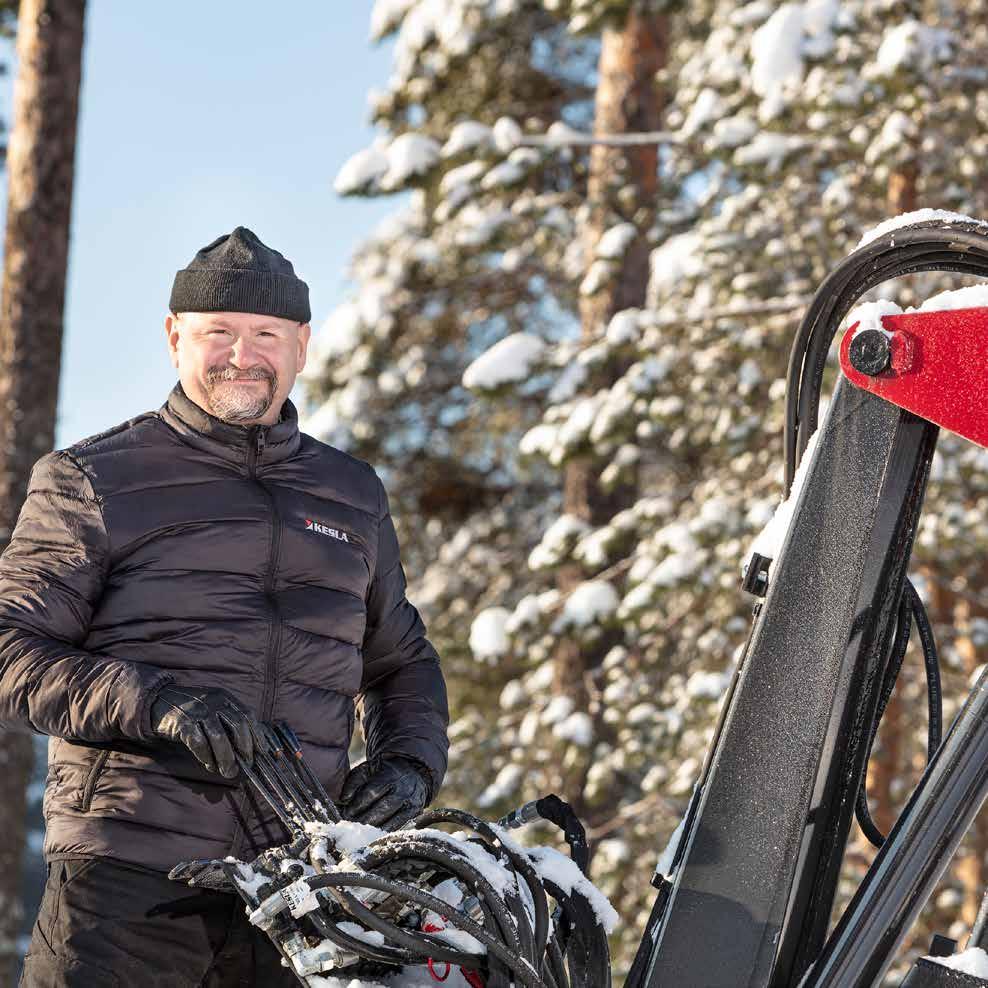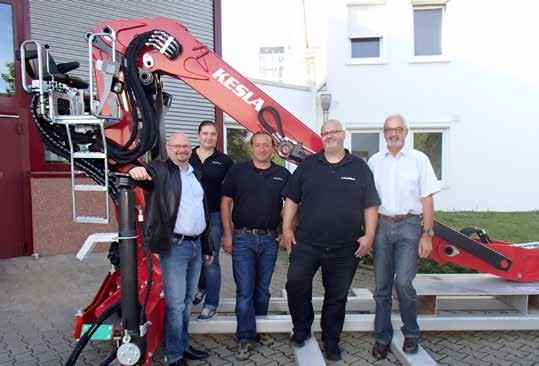
7 minute read
A horrible handicap
Simo Saastamoinen has been the Captain for Kesla since 2015.
Simo Saastamoinen started his work as Kesla’s CEO in 2015. Kesla was a company in crisis, with a gearing of 140% and empty coffers. The crisis was brought about not only by fluctuations in the world economy, but also by internal action.
As a result of the crisis in the Crimea, it was suddenly quiet on the eastern front of the market; Russia, Belarus, Ukraine, the Baltic States and part of Central Europe were at a standstill. The total investment load for 2013 and 2014 was approximately €9 million. The misfortunes also included increasing sales receivables. At the same time, MFG Components was operating at a loss. MFG’s import business, which had previously been more profitable, had already fallen as digitalisation changed customer behaviour. As a result, the closure of the Ilomantsi factory was close. There were also problems in Germany, where Kesla had quickly established its own subsidiary Kesla GmbH in 2012. It was clear from the outset that the start-up of a subsidiary would incur costs in the first years. It came as a surprise that Kesla had entered the German market with incomplete initial data. The weight limits for transports there are significantly lower than those in Finland. With that fact, Kesla’s sturdy and heavy timber handling cranes proved too heavy for the Germans. The crane model had to be changed, made lighter. It took time and cost a lot of money. The company had made a significant error of judgement.

Kesla GmbH personnel: Simo Saastamoinen (left), Elke Vogel, Achim Weidner, Werner Ziefle and Bernhard Huber, now retired.
Corrections
CEO Saastamoinen had to start taking the company towards a clear change. As several Kesla employees have said afterwards, there was a situation where “something had to be done”. There was a financial crisis. Saastamoinen’s first task was to agree on procedures with the company’s investors.
The company started reorganising its business operations.

Tall and thin trees in Thailand.
“Pretty much at the beginning, I said that the way it was going, the company would not exceed €50 million in turnover. The processes were unclear and so were the competitive strategies of business operations. We had to seek a more systematic approach and think about what business we want to be in, who our customers are, what our competitive advantages and strengths are.”
Kesla established its own business organisations for truck-mounted and industry cranes, timber harvesting equipment and tractor equipment. The goal was to shake an organisation set in its ways to see the company as a whole from the perspective of its customers – to understand the systemic thinking demanded by Saastamoinen. The CEO established new operating methods in the organisation. Among other things, every Monday the situation in the supply chain was reviewed together. In 2017, corrections were carried out in connection with the German subsidiary. The number of employees was reduced and the spare parts stock was transferred to Finland. As regards MGF Components, the solution was to make Kesla’s strategically important Ilomantsi factory part of Kesla in 2016 and sell MFG’s businesses. MFG’s manufacturing business was sold to Kotka Power Tech Oy in September 2017. In autumn 2018, Kesla announced that it had sold MFG’s import business to Tools Finland Oy. At various stages of the process, the Group’s parent company recognised a total of over €2.6 million of impairment in its MFG investment. The big news was that Kesla discontinued its long-term cooperation with Hankkija and entered into a partnership with ACGO Finland and Valtra in 2016.
A streamlining strategy process
It took a lot of work to get through those difficult times. Kesla also had a lot of luck. The rapid recovery of demand in the Russian market contributed to the end of the difficulties of the Ilomantsi factory. The cooperation with Valtra, in turn, brought a whole new kind of drive to Kesla. The company’s strategy work, launched in 2018, clarified the common tune that Simo Saastamoinen and his orchestra want to play. Business-specific targets were clarified. It all motivated people, who had learned to look at the company’s businesses as a whole and succeeded in increasing communication both in-house and towards customers. In 2016, the success in the Thai market was more good news. The Kesla team had done thorough groundwork, built trust with customers and managed to beat their competitors also in the speed of the service.
Both Kesla’s turnover and profit have seen good growth during Saastamoinen’s time as CEO. The problem that emerged at the end of 2019 regarding the durability of the crane columns was a setback. The durability problem concerns KESLA 2124L cranes – the ones that had to be urgently developed for the German market in early 2012. In accordance with its responsibility value, Kesla promised to replace the columns of all of these cranes delivered from 2013 onwards with a new reinforced construction. The operation made a dent of approximately €700,000 in the company’s profit. At the end of 2019, Simo Saastamoinen reiterated his earlier message: Kesla aims to increase performance on a permanent and reliable basis.
System thinker Saastamoinen
Simo Saastamoinen, who was born in Uimaharju in North Karelia, is a graduate engineer. He also holds a Master of Science degree from Cranfield Institute of Technology in the United Kingdom. His career started at Suomen Posti Oy, where worked as production Planning Manager, Product Manager and Product Group Manager.
Saastamoinen joined Perlos in 1999 when he and his family moved back to the Joensuu region. In 2001, he was appointed Director for Procurement and Logistics. His Perlos career was also the source of his systemic thinking – extremely fast paced and global business showed how everything affects everything; if any part of the system changes, the change inevitably affects the whole. From 2008 to 2011, Saastamoinen worked for Lite-On Mobile, a Taiwanese company. He was responsible for managing the global business supply chain. Lite-On Mobile acquired Perlos in Finland in 2007. While working for the Taiwanese company, Saastamoinen spent the year 2010 in China. After returning to Finland, Saastamoinen left Lite-On Mobile with the intention of taking a well-deserved sabbatical. It was important for him to have time for his mother’s terminal care, his father and family. When Kesla advertised for a marketing director in 2012, Simo Saastamoinen applied for the position, but was not elected. Mika Tahvanainen was appointed as Marketing Director.
A little later Marke Tyrväinen, then Managing Director of Kesla, was moving on to a new job. Kesla’s management contacted Saastamoinen asking if he would be interested in a position as Kesla’s CFO. “I had run internal accounting, but I was not an accountant. Becoming CFO felt like jumping into a black well,” says Saastamoinen, describing his jump out of his comfort zone. He said that working on his first financial statements with the company accountant at the time brought him to tears. “I really learned to appreciate financial professionals! In retrospect, I believe that it would be a good idea for everyone at management level to go through the financial reporting process. In that process, the numbers, contents or schedules are unyielding. The only part of the equation that yields is man.” Simo Saastamoinen was appointed Kesla’s CEO in 2015. In the demanding position, everything he has experienced in his career before has proved to be a special resource. Saastamoinen says that it was in the telecommunications industry that he learned systemic thinking.
Solving one single problem does not eliminate the root causes of the problem. In systemic thinking, the causes of the problem are given a deeper look, paying special attention to bottlenecks.
Saastamoinen, who trusts the results of systemic thinking, says that well-designed is completely undone, but well-documented is completely done. When it comes to solving problems, one of his advantages as an executive is the three-year CFO position –
“I authorise people, I’m not afraid to let them make their own decisions. I look at the whole picture and note any bottlenecks. From my time as CFO, I have good monitoring tools – I see the situation evolving, and whether I need to react to something.”

Kesla’s 10,000th truck-mounted crane was handed over to Jaku Yhtiöt at FinnMETKO 2018.










